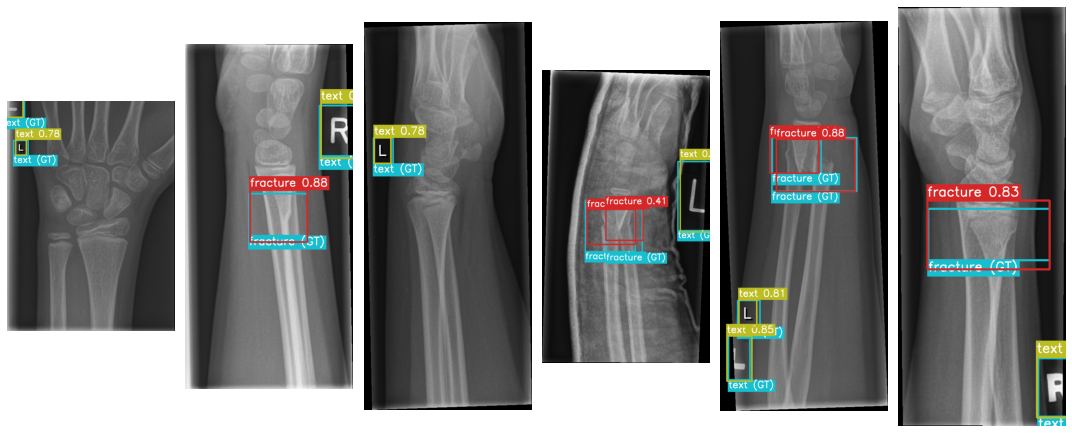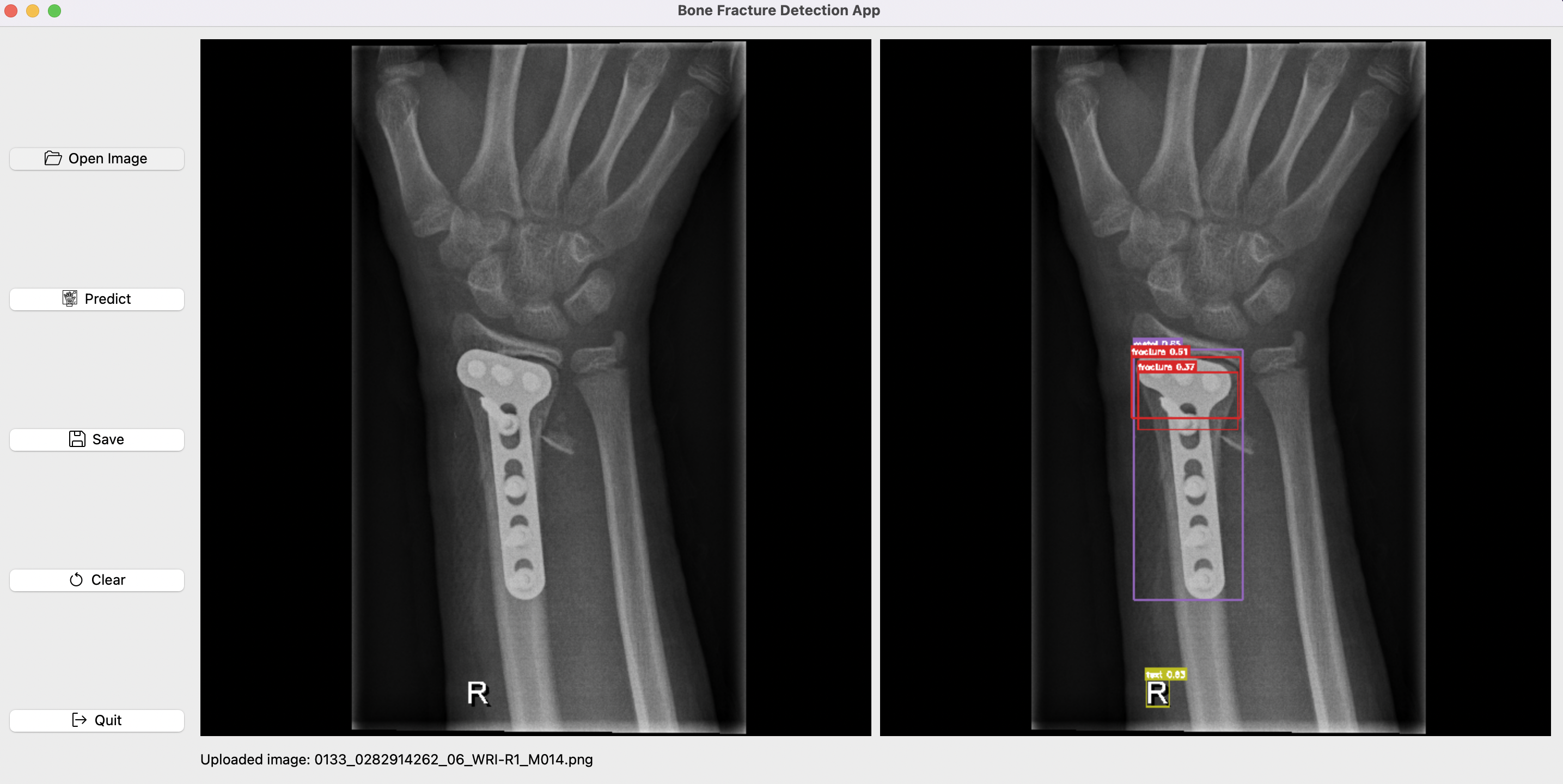Trained YOLOv7 for bone fracture detections.
The GRAZPEDWRI-DX is a open dataset containing 20327 annotated pediatric trauma wrist radiograph images of 6091 patients, treated at the Department for Pediatric Surgery of the University Hospital Graz between 2008 and 2018. Several pediatric radiologists annotated the images by placing bounding boxes to mark 9 different classes:
boneanomaly(276 boxes),bonelesion(45 boxes),foreignbody(8 boxes),fracture(18090 boxes),metal(818 boxes),periostealreaction(3453 boxes),pronatorsign(567 boxes),softtissue(464 boxes),text(23722 boxes).
 Fig1: few random testing images visualization within their realive ground-truth and the predicted labels with their confidence score by the trained YOLOv7-p6 model.
Fig1: few random testing images visualization within their realive ground-truth and the predicted labels with their confidence score by the trained YOLOv7-p6 model.
The data are already annotate in many different formats, one of the is the YOLO one. Indeed, YOLOv7 is the chosen model for this project.
First download the YOLOv7 repo:
git clone https://github.com/WongKinYiu/yolov7.git
cd yolov7
Then download the GRAZPEDWRI-DX dataset and stored it in the GRAZPEDWRI-DX_dataset folder. Keep the YOLO annotations (.txt files) and extract the images from the .zip into the images folder.
conda create -n yolov7 python=3.9
conda activate yolov7
pip install -r requirements.txt
The dataset iamges and annotatation are contained into data/full/images and data/full/labels respectively. The script:
python split.py
will divide the dataset into training, validation, and testing set (70-20-10 %) according to the key patient_id stored in dataset.csv. The script then will move the files into the relative folder as it is represented here below.
└── GRAZPEDWRI-DX_dataset
├── yolov5
│ ├── images
│ └── labels
├── images
│ ├── train
│ │ ├── train_img1.png
│ │ └── ...
│ ├── valid
│ │ ├── valid_img1.png
│ │ └── ...
│ └── test
│ ├── test_img1.png
│ └── ...
└── labels
├── train
│ ├── train_annotation1.txt
│ └── ...
├── valid
│ ├── valid_annotation1.txt
│ └── ...
└── test
├── test_annotation1.txt
└── ...
The script will create 3 files: train_data.csv, valid_data.csv, and test_data.csv with the same structure of dataset.csv.
You can download the models from Releases on the right banner. On the other hand you can also download them typing on your terminal:
wget https://github.com/mdciri/YOLOv7-Bone-Fracture-Detection/releases/download/trained-models/yolov7-p6-bonefracture.onnx
or
wget https://github.com/mdciri/YOLOv7-Bone-Fracture-Detection/releases/download/trained-models/yolov7-p6-bonefracture.pt
It is available the ONNX model in ./yolov7-p6-bonefracture.onnx, and inferece can be performed:
python inference_onnx.py --model-path <onnx model path> --img-path <input image path> --dst-path <destination folder for predictions>
for example:
python inference_onnx.py --model-path ./yolov7-p6-bonefracture.onnx --img-path ./GRAZPEDWRI-DX_dataset/images/test/0038_0775938745_03_WRI-L2_M014.png --dst-path ./predictions
The results (the predicted labelled image in .png file, and the predicted labels in .txt file) in the destination folder indicated. Each detection is saved as:
<class> <confidence_score> <bbox_Xcenter> <bbox_Ycenter> <bbox_Width> <bbox_Height>
N.B.: remeber to install the requirements:
pip install onnx onnxruntime
python gui/gui.py
GUI icons were made by Freepik, smashingstocks, photo3idea_studio, Yogi Aprelliyanto, Muhammad Ali, and dmitri13 from www.flaticon.com.
The GUI is done using PySide6, so first install it with:
pip install PySide6
Fig2: Bone Fracture Detection GUI.
streamlit run app/webapp.py
Fig3: Bone Fracture Detection WebApp made with streamlit.
docker pull mdciri/bone-fracture-detection:latest
docker run -p 8501:8501 mdciri/bone-fracture-detection
The torch model is also available in ./yolov7-p6-bonefracture.pt and you can evaluate it or perform inference using test.py and detect.py script respectively of the YOLOv7 repo. On the contrary, if you want to train the model, use train.py.
The evaluation of the 3 different datasets is collected in the runs/test folder. For each dataset are saved the predicted labels by the model, the confusion matrix, the F1, P, R, and PR curve plot.
GNU General Public License v3.0 as the YOLOv7 lincense.






